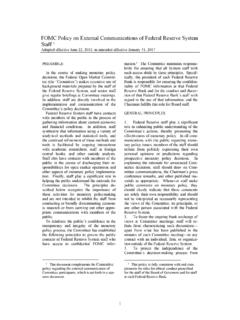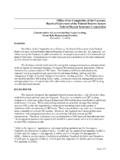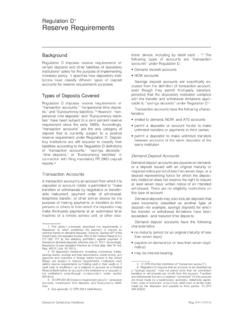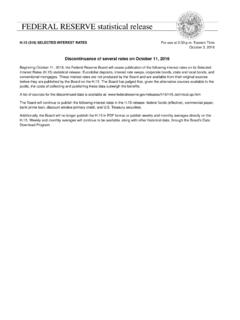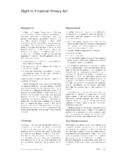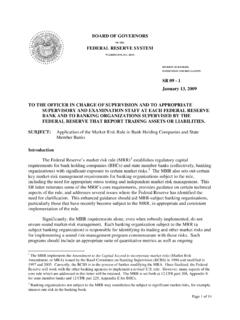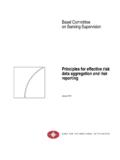Transcription of Basel II: International Convergence of Capital …
1 Basel Committee on Banking Supervision International Convergence of Capital Measurement and Capital Standards A Revised Framework June 2004 Requests for copies of publications, or for additions/changes to the mailing list, should be sent to: Bank for International Settlements Press & Communications CH-4002 Basel , Switzerland E-mail: +41 61 280 9100 and +41 61 280 8100 Bank for International Settlements 2004. All rights reserved. Brief excerpts may be reproduced or translated provided the source is stated. ISBN print: 92-9131-669-5 ISBN web: 92-9197-669-5 Table of Contents Abbreviations .. i Introduction .. 1 Part 1: Scope of Application .. 7 I. Introduction .. 7 II. Banking, securities and other financial subsidiaries .. 7 III. Significant minority investments in banking, securities and other financial entities.
2 8 IV. Insurance entities .. 8 V. Significant investments in commercial entities .. 10 VI. Deduction of investments pursuant to this part .. 10 Part 2: The First Pillar Minimum Capital Requirements .. 12 I. Calculation of minimum Capital requirements .. 12 A. Regulatory Capital .. 12 B. Risk-weighted assets .. 12 C. Transitional arrangements .. 13 II. Credit Risk The Standardised Approach .. 15 A. Individual claims .. 15 1. Claims on sovereigns .. 15 2. Claims on non-central government public sector entities (PSEs) .. 16 3. Claims on multilateral development banks (MDBs) .. 16 4. Claims on banks .. 17 5. Claims on securities firms .. 18 6. Claims on corporates .. 18 7. Claims included in the regulatory retail portfolios.
3 19 8. Claims secured by residential property .. 20 9. Claims secured by commercial real estate .. 20 10. Past due loans .. 21 11. Higher-risk categories .. 21 12. Other assets .. 22 13. Off-balance sheet items .. 22 B. External credit assessments .. 23 1. The recognition process .. 23 2. Eligibility criteria .. 23 C. Implementation considerations .. 24 1. The mapping process .. 24 2. Multiple assessments .. 24 3. Issuer versus issues assessment .. 24 4. Domestic currency and foreign currency assessments .. 25 5. Short-term/long-term assessments .. 25 6. Level of application of the assessment .. 26 7.
4 Unsolicited ratings .. 26 D. The standardised approach credit risk mitigation .. 26 1. Overarching issues .. 26 (i) Introduction .. 26 (ii) General remarks .. 27 (iii) Legal certainty .. 27 2. Overview of Credit Risk Mitigation Techniques .. 27 (i) Collateralised transactions .. 27 (ii) On-balance sheet netting .. 30 (iii) Guarantees and credit derivatives .. 30 (iv) Maturity mismatch .. 30 (v) Miscellaneous .. 30 3. Collateral.
5 31 (i) Eligible financial collateral .. 31 (ii) The comprehensive approach .. 32 (iii) The simple approach .. 40 (iv) Collateralised OTC derivatives 40 4. On-balance sheet netting .. 41 5. Guarantees and credit derivatives .. 41 (i) Operational requirements .. 41 (ii) Range of eligible guarantors (counter-guarantors)/protection providers 44 (iii) Risk weights .. 44 (iv) Currency mismatches .. 45 (v) Sovereign guarantees and 45 6. Maturity mismatches .. 45 (i) Definition of maturity.
6 45 (ii) Risk weights for maturity mismatches .. 46 7. Other items related to the treatment of CRM techniques .. 46 (i) Treatment of pools of CRM techniques .. 46 (ii) First-to-default credit derivatives .. 46 (iii) Second-to-default credit derivatives .. 47 III. Credit Risk The Internal Ratings-Based Approach .. 48 A. Overview .. 48 B. Mechanics of the IRB Approach .. 48 1. Categorisation of exposures .. 48 (i) Definition of corporate exposures .. 49 (ii) Definition of sovereign exposures .. 51 (iii) Definition of bank exposures .. 51 (iv) Definition of retail exposures.
7 51 (v) Definition of qualifying revolving retail exposures .. 52 (vi) Definition of equity exposures .. 53 (vii) Definition of eligible purchased receivables .. 54 2. Foundation and advanced approaches .. 55 (i) Corporate, sovereign, and bank exposures .. 56 (ii) Retail exposures .. 56 (iii) Equity exposures .. 56 (iv) Eligible purchased receivables .. 57 3. Adoption of the IRB approach across asset classes .. 57 4. Transition arrangements .. 58 (i) Parallel 58 (ii) Corporate, sovereign, bank, and retail exposures .. 58 (iii) Equity exposures.
8 59 C. Rules for corporate, sovereign, and bank exposures .. 59 1. Risk-weighted assets for corporate, sovereign, and bank exposures .. 59 (i) Formula for derivation of risk-weighted assets .. 59 (ii) Firm-size adjustment for small- and medium-sized entities (SME) .. 60 (iii) Risk weights for specialised lending .. 60 2. Risk components .. 62 (i) Probability of default (PD) .. 62 (ii) Loss given default (LGD) .. 62 (iii) Exposure at default (EAD) .. 66 (iv) Effective maturity (M) .. 68 D. Rules for Retail Exposures .. 69 1. Risk-weighted assets for retail exposures .. 69 (i) Residential mortgage exposures .. 69 (ii) Qualifying revolving retail exposures.
9 70 (iii) Other retail exposures .. 70 2. Risk components .. 70 (i) Probability of default (PD) and loss given default (LGD) .. 70 (ii) Recognition of guarantees and credit derivatives .. 71 (iii) Exposure at default (EAD) .. 71 E. Rules for Equity Exposures .. 72 1. Risk-weighted assets for equity exposures .. 72 (i) Market-based approach .. 72 (ii) PD/LGD approach .. 73 (iii) Exclusions to the market-based and PD/LGD approaches .. 74 2. Risk components .. 75 F. Rules for Purchased Receivables .. 75 1. Risk-weighted assets for default risk .. 76 (i) Purchased retail receivables.
10 76 (ii) Purchased corporate receivables .. 76 2. Risk-weighted assets for dilution risk .. 77 3. Treatment of purchase price discounts for 78 4. Recognition of credit risk 78 G. Treatment of Expected Losses and Recognition of Provisions .. 79 1. Calculation of expected losses .. 79 (i) Expected loss for exposures other than SL subject to the supervisory slotting criteria .. 79 (ii) Expected loss for SL exposures subject to the supervisory slotting criteria .. 79 2. Calculation of provisions .. 80 (i) Exposures subject to IRB approach .. 80 (ii) Portion of exposures subject to the standardised approach to credit risk.


